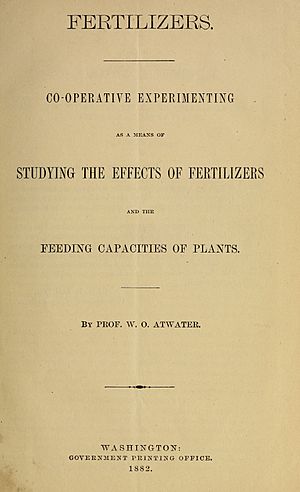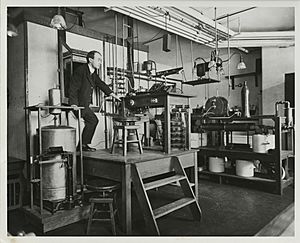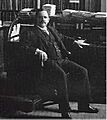Wilbur Olin Atwater facts for kids
Quick facts for kids
Wilbur Olin Atwater
|
|
|---|---|

Atwater's USDA portrait
|
|
| Born | May 3, 1844 |
| Died | September 22, 1907 (aged 63) Middletown, Connecticut, U.S.
|
| Nationality | American |
| Alma mater | Wesleyan University (BA) Yale University (PhD) |
| Known for | Atwater system, studies of human nutrition and metabolism |
| Scientific career | |
| Fields | Chemistry |
Wilbur Olin Atwater (born May 3, 1844 – died September 22, 1907) was an American chemist. He is famous for his studies on how humans get energy from food, called human nutrition and metabolism. Many people see him as the founder of modern nutrition science and education.
Atwater created the Atwater system. This system helped set up the study of nutrition in the United States. It even inspired how athletes eat for the modern Olympics.
He was the first director of the United States Agricultural Experiment Station at Wesleyan University in Middletown, Connecticut. He also became the first chief of nutrition research for the U.S. Department of Agriculture.
Contents
Early Life and Education
Wilbur Olin Atwater was born in Johnsburg, New York. His father was a minister and librarian. Atwater grew up in New England. Instead of fighting in the American Civil War, he went to college.
He studied at the University of Vermont and then at Wesleyan University. He finished his general studies in 1865. For the next three years, Atwater worked as a teacher.
In 1868, he joined Yale University to study agricultural chemistry. He learned about analyzing fertilizers and did the first chemical analysis of food in the U.S. He earned his doctorate degree in 1869. His research was on different types of corn.
After Yale, Atwater studied in Germany for two years. He learned about how the body uses food (physiological chemistry). He also saw how European agricultural experiment stations worked. He studied with famous scientists like Carl von Voit.
When he returned to the U.S. in 1871, Atwater taught chemistry. He taught at East Tennessee University and later at Maine State College. In 1874, he married Marcia Woodard. They had a daughter, Helen, and a son, Charles.
Building Agricultural Science
Wilbur Atwater became a chemistry professor at Wesleyan University in 1873. He stayed there until he died in 1907. He and his mentor, Samuel Johnson, wanted to create agricultural experiment stations in the U.S., like those in Europe.
Atwater wrote a report in 1875 for the Department of Agriculture about the German stations. To start one in Connecticut, a man named Orange Judd donated money. Wesleyan University offered lab space and Atwater's help.
In 1875, the first agricultural experiment station in the U.S. was created. It received $5,600 from the Connecticut government for a two-year trial. Atwater led this station from 1875 to 1877. Their first research focused on fertilizers.
Even after the trial, Atwater continued his research on farms. He became very interested in how plants use nutrients. He was one of the first to show that plants like legumes can take nitrogen from the air.
Atwater also wrote many articles for science magazines. He shared his findings in chemistry and what he learned from research abroad. Many of his articles appeared in a column called "Science Applied to Farming."
Human Nutrition Research
As Atwater's work became known, he was asked to help with many projects. From 1879 to 1882, he studied human food for the U.S. Fish Commission and the Smithsonian Institution. He looked at the nutrients in North American fish.
In 1882, Atwater went back to Germany to study how well lean fish could be digested. He found that fish was as good as lean beef. He saw how German scientists studied nutrition and wanted to bring similar research to the U.S.
In 1885, Atwater studied family food purchases. He calculated the daily amounts of carbohydrates, fat, and protein people were getting. He also suggested ways to eat healthier meals that cost less money.
Atwater kept pushing for more state agricultural experiment stations. He and Johnson advised Congress and President Grover Cleveland. They wanted to create stations at the land-grant colleges.
In 1887, the Hatch Act was passed. This law gave federal money to land-grant colleges to start experiment stations. Atwater became the director of the second Connecticut station at Storrs Agricultural College.
The Office of Experiment Stations was created in 1888 to oversee these stations. Atwater was chosen as its first director. He wanted to connect all the stations and share scientific work. He started a journal called the Experiment Station Record for scientists. He also helped create Farmers' Bulletin to share research findings with farmers in an easy-to-understand way.
Breakthroughs in Nutrition Science
Atwater was always interested in human nutrition. The Storrs experiment station became known for its nutrition studies. In 1891, he left his director role to focus only on nutrition research. He became a special agent for nutrition programs.
He organized many studies:
- Analyzing the chemical makeup of foods.
- Studying how well food is digested.
- Measuring how much energy humans need.
- Looking at the cost of food.
In 1894, Atwater received money from Congress for his human nutrition lab. His studies helped create dietary standards. These standards were based on average food intake. He knew they would change based on a person's age, sex, and activity level.
Atwater wanted to study metabolism more deeply. He worked with physicist Edward Bennett Rosa and nutritionist Francis Gano Benedict. They designed the first large machine to measure human energy, called a respiration calorimeter.
This machine could measure the energy from food very precisely. Atwater wanted to see how the body used nutrients during rest and work. The calorimeter measured the heat a person produced while doing activities.
In 1896, they began experiments with people inside the calorimeter. The machine was like a small room (7 feet long, 4 feet wide, 6 feet high). A person could eat, drink, work, rest, and sleep inside. Fresh air flowed in, and the temperature was kept comfortable. Food and waste were passed through a small opening.
Through these experiments, they created the Atwater system. This system measures energy in units called food calories. They showed that the first law of thermodynamics (energy cannot be created or destroyed) applies to humans too. They proved that any energy from food that the body didn't use was stored.
Atwater's research made people more aware of the food calorie. He showed that different foods give different amounts of energy. He published tables comparing calories in various foods.
Atwater also studied how the body uses alcohol. His findings showed that humans could get heat from alcohol, similar to how they get heat from carbohydrates. This was important at a time when some groups doubted alcohol had any nutritional value. Atwater showed alcohol could be used as fuel by the body.
Later Life and Lasting Impact
In 1904, Atwater had a stroke and could no longer work. He passed away in 1907. He is buried in Indian Hill Cemetery in Middletown, Connecticut.
His work continued through his colleagues. His partner, Francis Benedict, carried on his research. Benedict helped create a Nutrition Laboratory in Boston. He used the respiration calorimeter to study metabolism in many different groups of people. He even made a portable calorimeter.
Atwater's legacy is still important today. He and Samuel Johnson helped focus agricultural experiment stations on scientific study for the public good. The tables and formulas Atwater created are still used.
His careful studies helped create government policies to fight hunger in children. His influence can be seen on food labels in grocery stores and on restaurant menus. The familiar food pyramid, which guides healthy eating, is a tribute to his work.
Atwater's daughter, Helen W. Atwater, helped him in his lab. She later became a home economics expert and editor. His granddaughter, Catherine Merriam Atwater, married economist John Kenneth Galbraith.
The United States Department of Agriculture, Agricultural Research Service holds a yearly W.O. Atwater Memorial Lecture. This lecture honors a scientist who has helped improve diet and nutrition worldwide. The Wilbur O. Atwater Laboratory at the University of Connecticut is also named after him.
Images for kids
See also
 In Spanish: Wilbur Olin Atwater para niños
In Spanish: Wilbur Olin Atwater para niños






